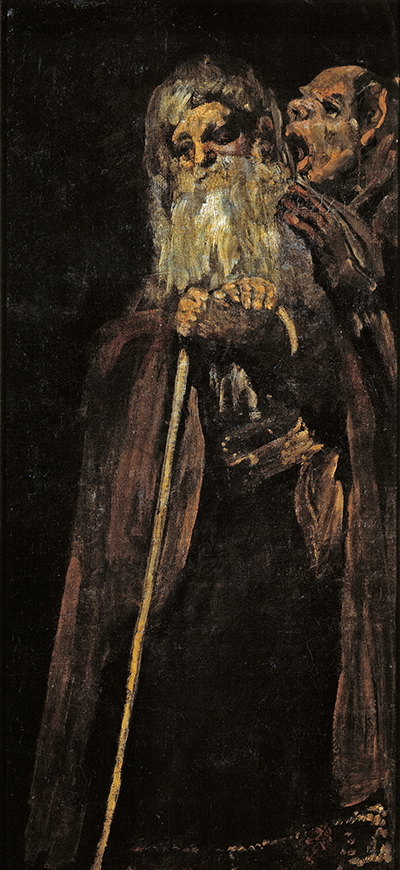Two Old Men is one of a number of darkly themed portraits produced by Francisco de Goya between the years of 1820-1823. They have since been transferred to canvas and are now stored at the Prado Museum in central Madrid.
Goya would create a good number of murals on the walls of the one of the rooms in his house. His work lasted between the years of 1820-1823 although he never intended these pieces for public consumption and so there is limited information available on the process around their production. On the positive side, we can see precisely how the artist would like to work in his own company, where no patrons were directing him in a particular way. The dark tones of these Black Paintings, as they have become known, were an accurate reflection of his own mood during these latter years. Ill health had reduced his more positive outlook and so influenced this change in his artistic output. One can compare this to some of his cartoon designs, for example, where country life is depicted with a postive slant and playful content.
Many are entirely unaware of the more upbeat Goya paintings, and know only of the darker themed pieces such as Two Old Men and Two Old Ones Eating Soup. He could transform the elderly into intimidating, almost frightening creatures with the correct use of lighting and tone. Goya removed the background detail almost entirely and produced portraits that remind us of the atmosphere of candlelight. The power of these images were extraordinary, and even lesser known artworks such as these are still important and significant pieces. We can also track the relative mood of the artist through his lifetime by comparing the different styles of oeuvre that appeared across the different periods. There would also be a contrast between how he worked under commission and then by his own free will.
This intriguing piece can be found in the collection of the Museo del Prado in Madrid, an institution which probably remains the best place to learn more about this artist's career by seeing his work in person. They have a great selection of artworks, covering the different styles in which he worked and have a good array of the Black Paintings such as the one found here. Visitors there will also be able to learn about the other great Spanish masters who are also very well represented but there are also others who starred in other parts of the continent too. All in all, it ranks as one of the finest collections of art history anywhere in the world, with a particular focus on post-Renaissance art up to the Impressionist era.




